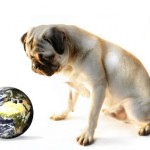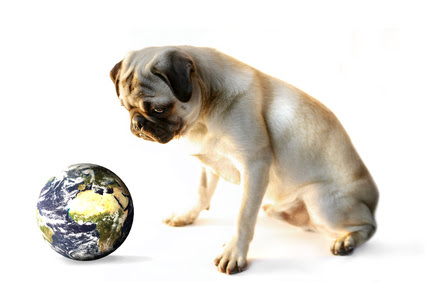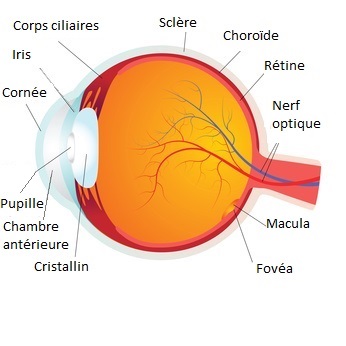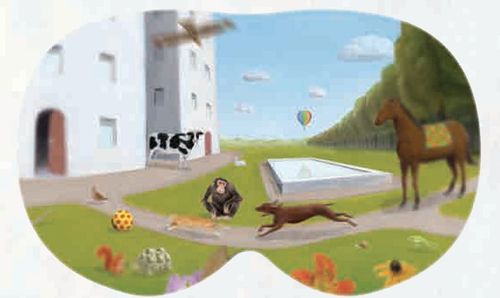
How do they see our animals worldwide ?
How our dogs, our cats do they see the world around them ?
This question concerned a very large number of us… Many attribute to our pets a vision in black and white… and yet, the black and white vision is a myth. In reality, animals are able to discern colors but their perception of images and colors is very different from ours.

To better understand what the animals see, here are some explanations on the structure and mode of operation of the eye :
Structure of the eye : The fundus is covered with a thin membrane called the retina. This membrane is covered with photoreceptors that capture light. There are two types of photoreceptors : – sticks by which the eye perceives light – cones that distinguish colors. The fovea is the area of the retina where the photoreceptors concentration is the most important.

All animals do not see in the same way. The vision of each species is determined by 4 items :
The field of view : This is the extent of space that the animal can be distinguished by setting straight ahead. The positioning of the eyes affects the field of view which can be very different from one animal to another.
Visual acuity : that is to say the ability to distinguish details with clarity. She is, She also, varies according to species and depend on factors such as the size of the eye, the number of photoreceptors found on the retina… Visual acuity of the frog, for example, is very bad.
The perception of movement : This is the ability to distinguish what moves. Some animals make up a very low visual acuity by a very good perception of movements. This is the case of the bee distinguishes very few details, who has a vision much worse than that of humans but sees great movement and can integrate 300 fps (which is 15 times man !).
The colors and lights : Color is a sensation produced by the light. His perception will be different depending photoreceptors present in the bottom of the eye and interpreted by the brain.
.
Here is a landscape seen by a human… 
© Book Illustration extracted Zooptique Guillaume Duprat Editions Seuil
Let's compare it now to see what various animals face the same scene…
See through the eyes of a dog ...
The dog is myopic : he can see what is close to him, but all that is far from over 5 meters it appears blurred. This myopia is more or less marked according to races : if the German Shepherd or Rottweiler are very nearsighted, the Saluki is little. The dog has a better perception of movements that man. While we perceive 20 fps, perceives him 50. This very good perception of movement explains why the dog is attracted to all objects or beings moving, a very useful feature for a predator like him ! Its field of view is wider than ours (240° against 180 °). It has a pretty good vision in relief, which serves much when hunting and wants to catch prey. On the other hand, it's hard to judge distances accurately. Finally, He sees colors, except red. The red objects are perceived in green or blue ! He is said dichromate. Generally speaking, he sees colors are duller than we distinguish. On the other hand, his vision in the dark is better than ours. ![]()
© Book Illustration extracted Zooptique Guillaume Duprat Editions Seuil
The world seen by cats…
Cat, on the other hand, is completely myopic ! He see 5 times less than man : beyond 75 cm distinguishes badly details and everything seems fuzzy him ! Fortunately, this great hunter has a field of view of 200 °, a very good perception of movement and excellent dimensional viewing (twice that of the dog). This allows it to be very skilled in hunting and easily capture the birds, mice ... The cat's retina has few cones. So hard to distinguish colors and does not distinguish between red and green, as colorblind ! It's like the dog a dichromate. On the other hand, the retina is very rich in rods and has a kind of reflecting mirror that holds the light. This is what makes the eyes of a brilliant cat in the dark. This mirror and many sticks allow him to see very well at night in the moonlight ! But beware, if the cat is plunged into complete darkness, without any light source, he sees nothing ! ![]()
© Book Illustration extracted Zooptique Guillaume Duprat Editions Seuil
The sharp eyes of the eagle…
The eagle is a large predator and a high-performance vision. He easily mark their prey up to a kilometer away ! It has three vision areas : Just before him, his eyes are like binoculars that magnify 6 to 8 After what he perceives. This is due to the presence of one million photoreceptors in the fovea. On the left and right, he has two viewing zones worst performing well but helpful to distinguish what is close to him. Its field of view is 240 ° and vision raised enough performance. He distinguishes the same colors as us but it is also capable of detecting ultraviolet. This vision in the ultra-violet allows it to locate traces of urine left by its prey and therefore easier to track ! The brow of the eagle gives him a fierce but she, in reality, a protective role : it protects the eye during the flight and reduce glare in strong sunlight. ![]()
© Book Illustration extracted Zooptique Guillaume Duprat Editions Seuil
We saw the world through the dog's eyes, cat and eagle… You know now how your pet receives his house, his master, the street, the gardens… and a poppy field does not appear to him in black and white but not black either !
§
All information and images in this article were taken from the excellent book "Zooptique" Guillaume Duprat to the Seuil youth. If you want to know more about the vision of the horse, cow or reptiles and insects, please read this beautiful book, it is worth the look !!!
